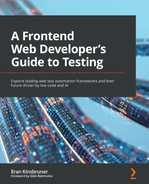Chapter 14: Wrapping Up
In this very thorough book that is aimed mainly at web application frontend developers, we've provided a complete compilation of all testing aspects that are important to keep web applications at high quality and performance. The book was divided into three parts, each building upon the ones before it.
To achieve continuous software delivery performance, both frontend developers and SDETs must keep evaluating their testing assets, reviewing their results, and maintaining and adding to their existing suites. In addition, knowing all options in the marketplace, both open source and commercial, can help practitioners to make better decisions and even combine multiple technologies to enhance testing coverage and capabilities.
In Part 1 of the book, we provided a deep overview of the web application testing types, the marketplace for frontend web application developers and testers, the key testing objectives, and the main roles that need to be concerned about these marketplaces. We also covered, in the first part, the variety of web application types, both legacy and emerging, such as PWAs, Flutter, React Native, and responsive.
In Part 2 of the book, we dived deeper into the world of frontend developers and provided instructions on building an efficient test plan from the ground up, as well as tools to measure success within the continuous testing of web applications. We then broke down the core capabilities of the leading JavaScript testing frameworks and covered items such as visual testing, accessibility testing, and API testing. We concluded the second part of the book with a dedicated chapter around code and test coverage analysis for web applications.
In Part 3, we dedicated most of the content to the most advanced features of the four leading open source web testing frameworks: Selenium, Cypress, Playwright, and Puppeteer. We concluded that part with an overview of intelligent web testing solutions that are based on low-code and codeless from within both the open source and commercial landscapes. We provided an overview for getting started with the three leading codeless tools on the market: Perfecto Codeless, Testim, and Mabl.
Throughout the entire book, I provided basic and advanced code samples with GitHub repository pointers and other references to help practitioners from all levels to get started or advance their testing skills and knowledge.
Major takeaways from the book
While writing this book, I solidified my belief that while there are many other open source test automation frameworks for web applications that are great and have nice capabilities, such as Robot (https://robotframework.org/), TestCafe (https://testcafe.io/), WebdriverIO (https://webdriver.io/), and CodeceptJS (https://codecept.io/), the most valuable and rich frameworks for frontend web application developers that should be considered are the four that we've covered.
The main insights to keep in mind are as follows:
- The web application testing marketplace is divided into three architecture-based frameworks:
- There are many commonalities between the four covered frameworks; however, each brings a unique value that the others don't. Hence, combining more than a single framework within the testing strategy might be a productive decision. For multi-skillset teams, consider the use of Selenium, which comes with more language bindings, and Playwright or Cypress, which add additional features, such as API testing, built-in code coverage, ease of debugging, and stronger codeless creation abilities.
- The future of web application testing will depend on the synergy between new and emerging commercial codeless tools and open source frameworks. If they can complement each other and maintain a proper balance of test coverage, stability, and maintainability, teams that adopt both types of solutions will be highly successful.
- Continuous testing for web applications must consider the entire digital landscape, which is both web and mobile platforms, PWAs, Flutter, React Native, and other types of modern applications. To remain competitive in the market across verticals (healthcare, insurance, finance, and so on), teams have to build stronger and higher-coverage test suites and shift left all testing types, including security, accessibility, APIs, and performance.
The software testing world for both web and other digital apps, including mobile and IoT, is constantly evolving and advancing. As a takeaway from this book, I recommend all developers and testers keep an eye on digital transformation-related trends, follow their industry-specific trends, and learn/adopt things that can improve their daily work and contribute to greater application quality.
You can find an additional set of references and links as follows to expand your knowledge and skills around web application testing with the aforementioned open source testing frameworks.
I do hope that this book will continue to contribute to your overall testing practices throughout the software development life cycle and beyond.
GitHub main repository – https://github.com/PacktPublishing/A-Frontend-Web-Developers-Guide-to-Testing
Useful references and bookmarks
For future reference and more examples and best practices, I recommend bookmarking the following.
Cypress framework-specific
- Cypress ambassadors – https://www.cypress.io/ambassadors/
- Cypress Gitter – https://gitter.im/cypress-io/cypress#
- Marie Drake's personal blog – https://www.mariedrake.com/blog
- Gleb Bahmutov – https://glebbahmutov.com/blog/
- Filip Hric's blog – https://filiphric.com/
- Cypress Courses by Gleb Bahmutov - https://cypress.tips/courses
Playwright framework-specific
- Microsoft Playwright documentation – https://docs.microsoft.com/en-us/microsoft-edge/playwright/
- Playwright community documentation – https://playwright.tech/
- A basic but useful getting started with Playwright guide – https://dev.to/leading-edje/automate-your-testing-with-playwright-1gag
- Extending Playwright testing with C# support – https://medium.com/version-1/playwright-a-modern-end-to-end-testing-for-web-app-with-c-language-support-c55e931273ee
- Execute automation YouTube Playwright tutorial – https://www.youtube.com/watch?v=2_BPIA5RgXU
- Playwright Slack channel – https://playwright.slack.com/join/shared_invite/zt-smuwd93l-Itgcv8IKYaF~wRnLQl4UMg#/shared-invite/email
Selenium framework-specific
- Online Selenium tutorial – https://artoftesting.com/selenium-tutorial
- Selenium testing guide by Mozilla – https://developer.mozilla.org/en-US/docs/Learn/Tools_and_testing/Cross_browser_testing/Your_own_automation_environment
Puppeteer framework-specific
- Google Developers Puppeteer guides:
- Puppeteer official documentation – https://devdocs.io/puppeteer/
- Getting started with Puppeteer: an insightful blog – https://codoid.com/puppeteer-tutorial-the-complete-guide-to-using-a-headless-browser-for-your-testing/
